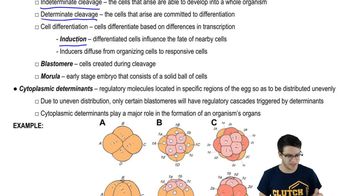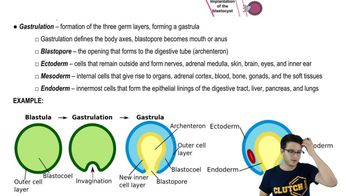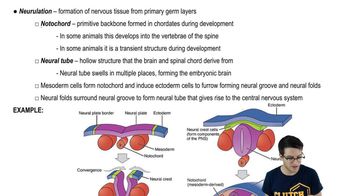Table of contents
- 1. Introduction to Biology2h 42m
- 2. Chemistry3h 40m
- 3. Water1h 26m
- 4. Biomolecules2h 23m
- 5. Cell Components2h 26m
- 6. The Membrane2h 31m
- 7. Energy and Metabolism2h 0m
- 8. Respiration2h 40m
- 9. Photosynthesis2h 49m
- 10. Cell Signaling59m
- 11. Cell Division2h 47m
- 12. Meiosis2h 0m
- 13. Mendelian Genetics4h 44m
- Introduction to Mendel's Experiments7m
- Genotype vs. Phenotype17m
- Punnett Squares13m
- Mendel's Experiments26m
- Mendel's Laws18m
- Monohybrid Crosses19m
- Test Crosses14m
- Dihybrid Crosses20m
- Punnett Square Probability26m
- Incomplete Dominance vs. Codominance20m
- Epistasis7m
- Non-Mendelian Genetics12m
- Pedigrees6m
- Autosomal Inheritance21m
- Sex-Linked Inheritance43m
- X-Inactivation9m
- 14. DNA Synthesis2h 27m
- 15. Gene Expression3h 20m
- 16. Regulation of Expression3h 31m
- Introduction to Regulation of Gene Expression13m
- Prokaryotic Gene Regulation via Operons27m
- The Lac Operon21m
- Glucose's Impact on Lac Operon25m
- The Trp Operon20m
- Review of the Lac Operon & Trp Operon11m
- Introduction to Eukaryotic Gene Regulation9m
- Eukaryotic Chromatin Modifications16m
- Eukaryotic Transcriptional Control22m
- Eukaryotic Post-Transcriptional Regulation28m
- Eukaryotic Post-Translational Regulation13m
- 17. Viruses37m
- 18. Biotechnology2h 58m
- 19. Genomics17m
- 20. Development1h 5m
- 21. Evolution3h 1m
- 22. Evolution of Populations3h 52m
- 23. Speciation1h 37m
- 24. History of Life on Earth2h 6m
- 25. Phylogeny2h 31m
- 26. Prokaryotes4h 59m
- 27. Protists1h 12m
- 28. Plants1h 22m
- 29. Fungi36m
- 30. Overview of Animals34m
- 31. Invertebrates1h 2m
- 32. Vertebrates50m
- 33. Plant Anatomy1h 3m
- 34. Vascular Plant Transport1h 2m
- 35. Soil37m
- 36. Plant Reproduction47m
- 37. Plant Sensation and Response1h 9m
- 38. Animal Form and Function1h 19m
- 39. Digestive System1h 10m
- 40. Circulatory System1h 57m
- 41. Immune System1h 12m
- 42. Osmoregulation and Excretion50m
- 43. Endocrine System1h 4m
- 44. Animal Reproduction1h 2m
- 45. Nervous System1h 55m
- 46. Sensory Systems46m
- 47. Muscle Systems23m
- 48. Ecology3h 11m
- Introduction to Ecology20m
- Biogeography14m
- Earth's Climate Patterns50m
- Introduction to Terrestrial Biomes10m
- Terrestrial Biomes: Near Equator13m
- Terrestrial Biomes: Temperate Regions10m
- Terrestrial Biomes: Northern Regions15m
- Introduction to Aquatic Biomes27m
- Freshwater Aquatic Biomes14m
- Marine Aquatic Biomes13m
- 49. Animal Behavior28m
- 50. Population Ecology3h 41m
- Introduction to Population Ecology28m
- Population Sampling Methods23m
- Life History12m
- Population Demography17m
- Factors Limiting Population Growth14m
- Introduction to Population Growth Models22m
- Linear Population Growth6m
- Exponential Population Growth29m
- Logistic Population Growth32m
- r/K Selection10m
- The Human Population22m
- 51. Community Ecology2h 46m
- Introduction to Community Ecology2m
- Introduction to Community Interactions9m
- Community Interactions: Competition (-/-)38m
- Community Interactions: Exploitation (+/-)23m
- Community Interactions: Mutualism (+/+) & Commensalism (+/0)9m
- Community Structure35m
- Community Dynamics26m
- Geographic Impact on Communities21m
- 52. Ecosystems2h 36m
- 53. Conservation Biology24m
20. Development
Animal Development
Problem 6`
Textbook Question
In humans, identical twins are possible because
a. Extraembryonic cells interact with the zygote nucleus.
b. Convergent extension occurs.
c. Early blastomeres can form a complete embryo if isolated.
d. The gray crescent divides the dorsal-ventral axis into new cells.
 Verified step by step guidance
Verified step by step guidance1
Understand the context: Identical twins, also known as monozygotic twins, occur when a single fertilized egg splits and develops into two embryos.
Consider the options: Each option describes a different biological process or concept. We need to identify which one is related to the formation of identical twins.
Option a: Extraembryonic cells are involved in forming structures like the placenta, not in splitting the zygote.
Option b: Convergent extension is a process during gastrulation that involves cell movement and tissue elongation, not related to twin formation.
Option c: Early blastomeres are cells formed during the early stages of embryonic development. If these cells are isolated, they have the potential to develop into a complete embryo, which is the basis for the formation of identical twins.
 Verified video answer for a similar problem:
Verified video answer for a similar problem:This video solution was recommended by our tutors as helpful for the problem above
Video duration:
2mPlay a video:
Was this helpful?
Key Concepts
Here are the essential concepts you must grasp in order to answer the question correctly.
Identical Twins Formation
Identical twins, or monozygotic twins, occur when a single fertilized egg, or zygote, splits into two separate embryos. This splitting usually happens during the early stages of embryonic development, leading to two genetically identical individuals. The process is distinct from fraternal twins, which result from two separate eggs being fertilized by two different sperm cells.
Recommended video:
Guided course

Formation & Breakdown of Polysaccharides
Blastomeres
Blastomeres are the cells formed by the division of the fertilized egg during the early stages of embryonic development. In some species, including humans, early blastomeres have the potential to develop into a complete embryo if they become isolated. This totipotency is crucial for the formation of identical twins, as it allows the separated cells to develop independently into two embryos.
Recommended video:
Guided course

Cleavage and Blastulation
Embryonic Development
Embryonic development is the process by which a fertilized egg transforms into a fully formed organism. It involves multiple stages, including cleavage, blastulation, gastrulation, and organogenesis. Understanding these stages is essential for comprehending how identical twins can form, as the splitting of the embryo typically occurs during the early cleavage stage, when cells are still totipotent.
Recommended video:
Guided course

Embryonic Plant Development
Related Videos
Related Practice




























